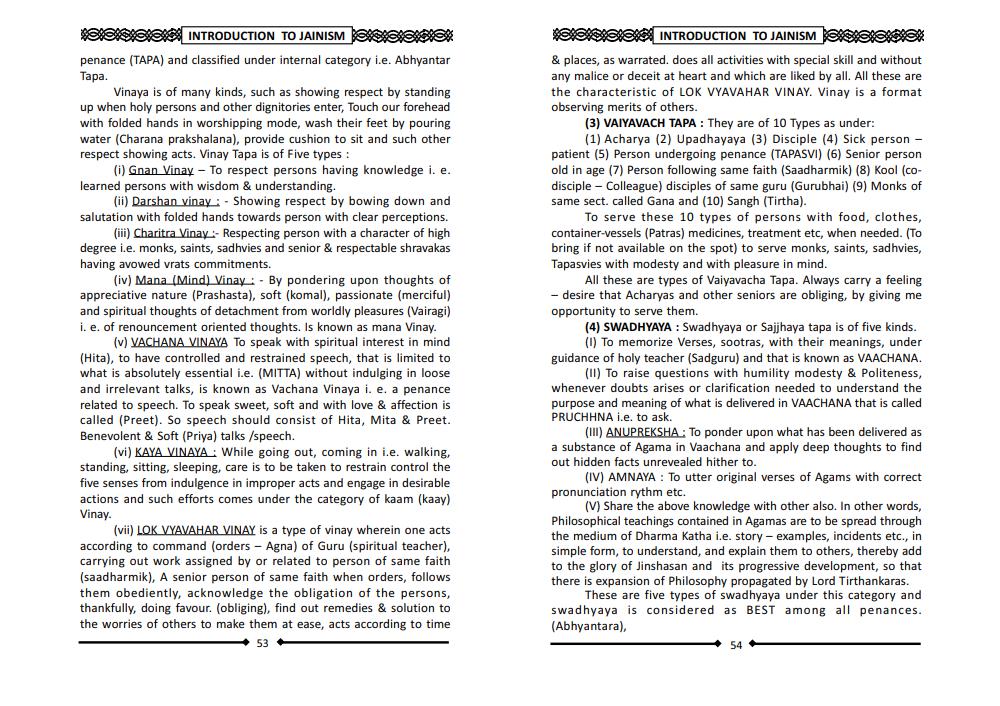________________
***INTRODUCTION TO JAINISM
****** penance (TAPA) and classified under internal category i.e. Abhyantar Tapa.
Vinaya is of many kinds, such as showing respect by standing up when holy persons and other dignitories enter, Touch our forehead with folded hands in worshipping mode, wash their feet by pouring water (Charana prakshalana), provide cushion to sit and such other respect showing acts. Vinay Tapa is of Five types:
(i) Gnan Vinay - To respect persons having knowledge i. e. learned persons with wisdom & understanding.
(ii) Darshan vinay: Showing respect by bowing down and salutation with folded hands towards person with clear perceptions. (iii) Charitra Vinay :- Respecting person with a character of high degree i.e. monks, saints, sadhvies and senior & respectable shravakas having avowed vrats commitments.
(iv) Mana (Mind) Vinay By pondering upon thoughts of appreciative nature (Prashasta), soft (komal), passionate (merciful) and spiritual thoughts of detachment from worldly pleasures (Vairagi) i. e. of renouncement oriented thoughts. Is known as mana Vinay. (v) VACHANA VINAYA To speak with spiritual interest in mind (Hita), to have controlled and restrained speech, that is limited to what is absolutely essential i.e. (MITTA) without indulging in loose and irrelevant talks, is known as Vachana Vinaya i. e. a penance related to speech. To speak sweet, soft and with love & affection is called (Preet). So speech should consist of Hita, Mita & Preet. Benevolent & Soft (Priya) talks /speech.
(vi) KAYA VINAYA: While going out, coming in i.e. walking, standing, sitting, sleeping, care is to be taken to restrain control the five senses from indulgence in improper acts and engage in desirable actions and such efforts comes under the category of kaam (kaay) Vinay.
(vii) LOK VYAVAHAR VINAY is a type of vinay wherein one acts according to command (orders - Agna) of Guru (spiritual teacher), carrying out work assigned by or related to person of same faith (saadharmik), A senior person of same faith when orders, follows them obediently, acknowledge the obligation of the persons, thankfully, doing favour. (obliging), find out remedies & solution to the worries of others to make them at ease, acts according to time
53
33333
INTRODUCTION TO JAINISM
& places, as warrated. does all activities with special skill and without any malice or deceit at heart and which are liked by all. All these are the characteristic of LOK VYAVAHAR VINAY. Vinay is a format observing merits of others.
(3) VAIYAVACH TAPA: They are of 10 Types as under:
(1) Acharya (2) Upadhayaya (3) Disciple (4) Sick person - patient (5) Person undergoing penance (TAPASVI) (6) Senior person old in age (7) Person following same faith (Saadharmik) (8) Kool (codisciple - Colleague) disciples of same guru (Gurubhai) (9) Monks of same sect. called Gana and (10) Sangh (Tirtha).
To serve these 10 types of persons with food, clothes, container-vessels (Patras) medicines, treatment etc, when needed. (To bring if not available on the spot) to serve monks, saints, sadhvies, Tapasvies with modesty and with pleasure in mind.
All these are types of Vaiyavacha Tapa. Always carry a feeling - desire that Acharyas and other seniors are obliging, by giving me opportunity to serve them.
(4) SWADHYAYA : Swadhyaya or Sajjhaya tapa is of five kinds. (1) To memorize Verses, sootras, with their meanings, under guidance of holy teacher (Sadguru) and that is known as VAACHANA. (II) To raise questions with humility modesty & Politeness, whenever doubts arises or clarification needed to understand the purpose and meaning of what is delivered in VAACHANA that is called PRUCHHNA i.e. to ask.
(III) ANUPREKSHA: To ponder upon what has been delivered as a substance of Agama in Vaachana and apply deep thoughts to find out hidden facts unrevealed hither to.
(IV) AMNAYA: To utter original verses of Agams with correct pronunciation rythm etc.
(V) Share the above knowledge with other also. In other words, Philosophical teachings contained in Agamas are to be spread through the medium of Dharma Katha i.e. story - examples, incidents etc., in simple form, to understand, and explain them to others, thereby add to the glory of Jinshasan and its progressive development, so that there is expansion of Philosophy propagated by Lord Tirthankaras. These are five types of swadhyaya under this category and swadhyaya is considered as BEST among all penances. (Abhyantara),
54




